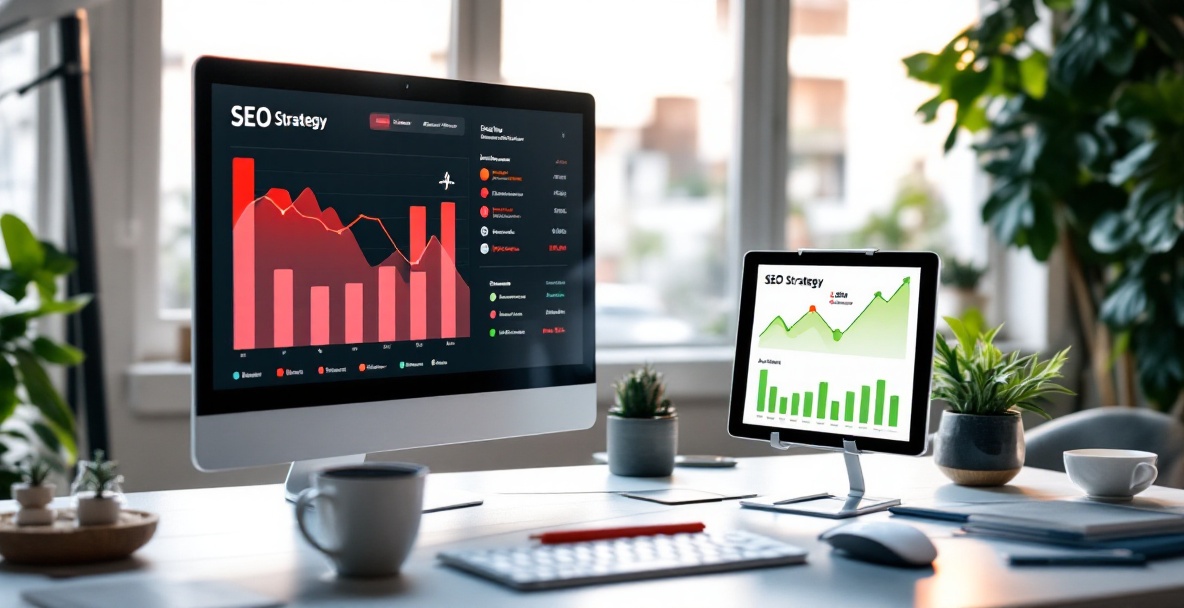The battle for search visibility increasingly demands strategic decision-making about resource allocation between on-page and technical SEO. Many marketing professionals find themselves asking: which deserves more attention? The answer isn't about choosing one over the other, but understanding how these complementary approaches work together to create a comprehensive optimization strategy. At SEO Tuts, we've seen firsthand how balancing these elements properly can transform search performance while maximizing return on investment.
Understanding the SEO Divide: A Strategic Approach

The relationship between on-page and technical SEO is symbiotic. On-page SEO focuses on optimizing content and user experience elements visible to visitors, while technical SEO addresses the behind-the-scenes infrastructure that supports your site's performance in search engines. Both are essential components of a complete optimization strategy.
Think of on-page SEO as the visible part of an iceberg – the content users directly engage with. Technical SEO represents the larger mass beneath the surface – invisible to average users but providing the critical foundation that keeps everything afloat. Neither can succeed fully without the other.
The Evolution of SEO
SEO has transformed dramatically since its inception. Early optimization efforts centered primarily on keyword stuffing and manipulative tactics. Today, effective SEO requires a sophisticated understanding of search engine algorithms, user intent, and technical requirements.
The introduction of Google's major algorithm updates – from Panda and Penguin to more recent updates like BERT and the helpful content system – has progressively shifted focus toward quality content that genuinely serves user needs while demanding technical excellence. This dual emphasis makes understanding both on-page and technical SEO more important than ever.
Modern search engines now employ machine learning and artificial intelligence to determine relevance and quality, making simplistic approaches obsolete. The most successful SEO strategies address both the content users see and the technical structure search engines evaluate.
On-Page SEO: The Content and User Experience Foundation

On-page SEO encompasses everything users directly interact with on your website. This includes content quality, keyword optimization, meta tags, internal linking, and user experience elements. These factors communicate your page's relevance and value to both users and search engines.
The significance of on-page SEO cannot be overstated. While technical SEO provides the foundation, on-page elements deliver the signals that help search engines understand what your content is about and whether it satisfies user intent. Content that fails to engage users or address their needs will underperform regardless of technical excellence.
Content Optimization Essentials
Content optimization begins with understanding your audience's search intent. Are they looking for information, trying to make a purchase, or seeking a specific resource? Your content must align with this intent to be considered relevant.
Keywords remain fundamental, but their application has evolved. Rather than focusing solely on keyword density, successful optimization now requires semantic understanding – incorporating related terms, synonyms, and natural language patterns that reflect how people actually communicate about your topic.
Titles and headings serve dual purposes in modern SEO. They provide hierarchical structure for search engines while improving readability for users. Properly structured H1, H2, and H3 tags not only organize content logically but also provide opportunities to incorporate target keywords naturally.
Comprehensive content typically outperforms thin content in today's search landscape. Search engines favor depth and thoroughness, with top-ranking pages often covering topics extensively. This doesn't necessarily mean longer is always better, but rather that content should thoroughly address the user's query without unnecessary filler.
User Experience Factors
User experience has become increasingly central to SEO success. Search engines now consider engagement metrics like bounce rate, time on page, and page views as signals of content quality. Content that keeps users engaged sends positive signals to search algorithms.
Site structure and navigation influence both user experience and crawlability. Intuitive navigation helps users find what they need while enabling search engines to discover and understand your content hierarchy. Well-structured sites typically see better engagement metrics and improved crawl efficiency.
Mobile optimization is no longer optional. With Google's mobile-first indexing, how your site performs on mobile devices directly impacts your search visibility. Responsive design, appropriate text size, adequate spacing for touch elements, and fast loading times on mobile connections are fundamental requirements.
On-Page Optimization Tools and Techniques
Several tools can assist with on-page optimization efforts. Keyword research tools like SEMrush, Ahrefs, and Google's Keyword Planner help identify valuable search terms and analyze competitor strategies. Content analysis tools can evaluate readability, keyword usage, and topical coverage.
Effective on-page optimization techniques include creating descriptive URLs, optimizing image alt text, implementing schema markup, and developing strategic internal linking structures. These elements help search engines better understand and categorize your content while improving accessibility and user experience.
Regularly updating content keeps it fresh and relevant. Historical content optimization – revisiting and refreshing older content – often yields significant SEO benefits with relatively minimal effort compared to creating entirely new content.
Technical SEO: The Infrastructure of Search Success

Technical SEO focuses on how well search engines can access, crawl, interpret, and index your website. Without solid technical foundations, even exceptional content may fail to achieve visibility in search results. Technical optimization addresses the infrastructure issues that can prevent content from reaching its potential.
The complexity of technical SEO has increased as search engines have become more sophisticated. Modern technical optimization involves addressing a broad spectrum of issues from site architecture and mobile responsiveness to page speed and security protocols.
Core Technical SEO Elements
Site architecture forms the backbone of technical SEO. A logical structure helps search engines understand the relationships between different pages and content sections. Flat architectures, where important pages are accessible within a few clicks from the homepage, typically perform better than deep, complex structures.
XML sitemaps serve as roadmaps for search engines, helping them discover and prioritize content on your site. An effective sitemap strategy involves regularly updating your sitemap and ensuring it accurately reflects your site's current structure and priority pages.
Robots.txt files provide instructions to search engine crawlers about which parts of your site should or shouldn't be crawled. Proper implementation prevents crawlers from wasting resources on non-essential pages while ensuring important content remains accessible.
Site speed has become increasingly important for both user experience and search rankings. Technical measures to improve speed include optimizing images, leveraging browser caching, minifying code, and implementing content delivery networks (CDNs) to serve content from locations closer to users.
Technical SEO Audit Checklist Implementation
A comprehensive technical SEO audit examines numerous factors affecting search performance. Core elements include crawlability assessment, indexation status, URL structure analysis, and detection of duplicate content issues. Regular audits help identify potential problems before they significantly impact performance.
Conducting a thorough technical SEO audit ensures search engines can access all your important content. Common issues include broken links, redirect chains, and server errors that prevent proper crawling. Tools like Google Search Console provide valuable insights into crawl problems and indexation status.
HTTPS implementation has become a standard requirement for all websites. Beyond being a ranking signal, secure connections build user trust and protect sensitive information. Proper SSL certificate implementation and addressing mixed content issues are fundamental aspects of technical optimization.
Structured data markup helps search engines understand the context and relationships within your content. Implementing schema.org vocabulary can enhance search listings with rich results like star ratings, prices, or availability information, potentially improving click-through rates.
Performance Optimization
Page speed optimization directly impacts both user experience and search rankings. Core Web Vitals metrics – Largest Contentful Paint, First Input Delay, and Cumulative Layout Shift – have become official Google ranking factors, making performance optimization more important than ever.
Mobile optimization requires addressing technical aspects like viewport configuration, touch element sizing, and response times. With mobile-first indexing, Google primarily uses the mobile version of content for indexing and ranking, making mobile performance a priority for all sites.
JavaScript optimization has become increasingly important as sites rely more heavily on JS frameworks. Search engines have improved their ability to render JavaScript, but challenges remain. Implementing server-side rendering or dynamic rendering can help ensure proper indexation of JavaScript-heavy content.
Internationalization requires technical considerations like proper hreflang implementation, geotargeting settings, and URL structures for multi-language or multi-regional sites. These technical elements help search engines serve the appropriate content to users in different locations.
Resource Allocation: Creating the Perfect Balance

Determining the optimal allocation of resources between on-page and technical SEO requires strategic assessment of your current situation. The perfect balance will vary based on your site's existing strengths and weaknesses, competitive landscape, and business objectives.
Most successful SEO strategies require ongoing investment in both areas, but priorities may shift based on site maturity and immediate challenges. New sites often benefit from establishing strong technical foundations first, while established sites may need to focus more on content quality and optimization.
Assessment and Prioritization
Conducting comprehensive audits of both technical and on-page elements provides the data needed for strategic decision-making. These audits should identify critical issues, opportunities for improvement, and potential quick wins in each area.
Following a complete technical SEO checklist helps prioritize issues based on both impact and effort. Some technical issues may have catastrophic effects on search visibility and require immediate attention regardless of resource requirements. Similarly, on-page optimizations that align with high-value business objectives may deserve priority despite complexity.
Competitive analysis provides context for prioritization decisions. Understanding where competitors excel can highlight areas where improvements might yield competitive advantage. If competitors have strong technical foundations but weaker content, focusing on content quality might provide more immediate differentiation.
Budget and Resource Distribution
SEO budgeting involves allocating financial and human resources across various optimization activities. Effective budget planning requires understanding the costs associated with different types of optimization work, from content creation to technical implementation.
In-house vs. outsourced resource considerations affect budget allocation decisions. Some organizations maintain internal teams for ongoing content creation while outsourcing specialized technical work. Others may rely on agencies or consultants for comprehensive SEO support. Each approach has implications for resource allocation.
ROI expectations should inform resource distribution. Some SEO investments yield relatively quick returns, while others represent longer-term infrastructure improvements. A balanced approach typically includes a mix of quick wins and strategic long-term initiatives.
Action Plan: Implementing a Holistic SEO Strategy
Effective SEO implementation requires a structured approach that addresses both on-page and technical elements in a coordinated manner. A holistic strategy recognizes the interdependencies between different optimization efforts and prioritizes them accordingly.
The most successful SEO initiatives combine strategic planning with adaptability. Search algorithms and competitive landscapes constantly evolve, requiring ongoing adjustments to optimization approaches.
Creating Your SEO Roadmap
Developing a comprehensive SEO roadmap involves setting clear objectives, establishing timelines, and assigning responsibilities. An effective roadmap should outline both immediate priorities and longer-term initiatives across technical and on-page domains.
Technical foundations typically come first in implementation sequencing. Addressing critical technical issues that might prevent proper indexation or crawling ensures that subsequent on-page optimization efforts can achieve maximum impact.
Content development strategies should align with technical capabilities. Understanding technical constraints and opportunities helps inform content planning, ensuring that content initiatives leverage the site's technical strengths while working within its limitations.
Measuring Success and Adjusting Course
Establishing appropriate KPIs for both technical and on-page optimization helps track progress and demonstrate value. Technical metrics might include page speed scores, crawl stats, and indexation rates, while on-page metrics typically include rankings, organic traffic, and engagement measures.
Regular reporting and analysis cycles enable ongoing optimization. Reviewing performance data at consistent intervals helps identify trends, opportunities, and potential issues requiring attention. This continuous feedback loop supports iterative improvement.
Adapting to algorithm changes and industry developments requires staying informed about search evolution. Major algorithm updates may shift priorities between technical and on-page factors, necessitating strategic adjustments to resource allocation and implementation plans.
The journey to SEO success requires balancing technical excellence with compelling content. By understanding the unique contributions of both on-page and technical SEO, you can develop a strategy that maximizes your site's search potential while making efficient use of available resources.
Ready to develop your perfectly balanced SEO strategy? Visit SEO Tuts today to access our comprehensive guides on technical SEO audit implementation and search engine optimization fundamentals that will help you prioritize your efforts for maximum impact.
Leave a Reply